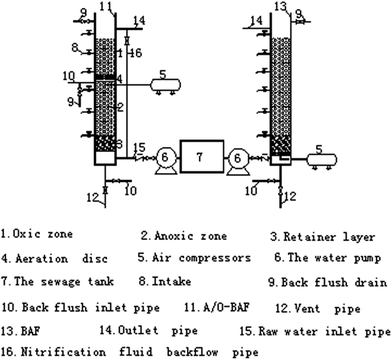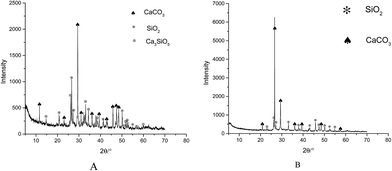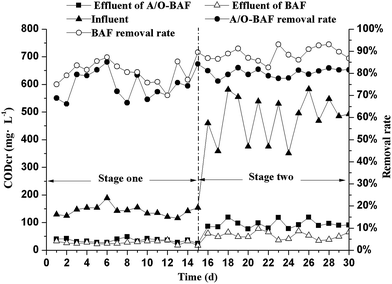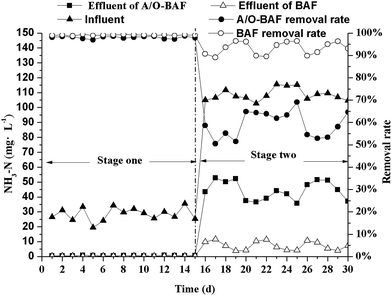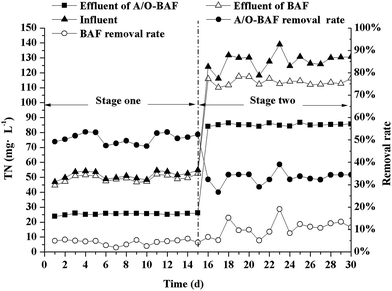Production of unburned calcium silicon filter material (UCSFM) from oyster shell and its performance investigation in an A/O integrated biological aerated filter reactor (A/O-BAF)
Yan Feng*ab,
Xing Lia,
Yanzhen Yua,
Jingyao Qib,
Xinqiang Jiac,
Juanting Wanga and
Xue Lia
aSchool of Civil Engineering and Architecture, University of Jinan, Jinan 250022, China. E-mail: fengyan584@163.com; Tel: +86-13853145786
bSchool of Municipal & Environmental Engineering, Harbin Institute of Technology, Harbin 150090, China
cSAES Environmental Science and Technology Co., Ltd., Jinan 250022, China
First published on 24th August 2016
Abstract
A considerable amount of the oyster shells as a waste product of mariculture is produced every year, which leads to a major disposal problem with coastal regions of China. This work researched the feasibility of utilizing oyster shell as raw materials to produce unburned calcium silicon filter material (UCSFM) in an unburned process. The chemical composition, physical property and microstructure of UCSFM were determined. The results indicated that oyster shells could be utilized to produce the UCSFM, which belongs to alkaline filter material. The UCSFM was invoked as a bio-carrier in an A/O integrated biological aerated filter reactor (A/O-BAF) for wastewater treatment, and its processing performance was investigated at different ammonia nitrogen loads. The CODcr and NH3–N removal rates of UCSFM BAF were slightly higher than UCSFM A/O-BAF, but UCSFM A/O-BAF showed a higher TN removal rate of ammonia nitrogen loads between 0.130 kg (m3 d)−1 and 0.496 kg (m3 d)−1 and the average TN removal rates of UCSFM A/O-BAF and UCSFM BAF were 41.88% and 7.48%, respectively. Pyrosequencing analysis of the 16S rRNA gene in anoxic/oxic zones of A/O-BAF process indicated that the microbial communities were quite different from different ammonia nitrogen loads. Thiobacillus, Thiothrix, Hydrogenophaga, Flavobacterium were the dominant genera shared in the oxic zones, while VadinHA17_norank, Desulfobacter, Aeromonas and SB-1_norank were the dominant genera shared in the anoxic zones. The microbial population and physicochemical properties of the UCSFMs explained the excellent performance of the UCSFM A/O-BAF reactor well. Therefore, the UCSFM produced from the oyster shell was appropriate for serving as a bio-carrier in A/O-BAF reactors.
1. Introduction
Oyster shell (OS) is a form of waste product that is produced by taking shellfish as a principal part of the food in China. A large amount of oyster shells are produced every year. As for Shandong Province, shellfish farms cover 63![[thin space (1/6-em)]](https://www.rsc.org/images/entities/char_2009.gif) 000 ha of coastal oceans and produce approximately 704
000 ha of coastal oceans and produce approximately 704![[thin space (1/6-em)]](https://www.rsc.org/images/entities/char_2009.gif) 900 kg of OS every year.1 Oyster shell waste brought about a great deal of social and environmental problems in coastal regions of China. For example, oyster shell waste can give off bad odors and contaminates the surrounding environment when it is dumped into coastal water or reclaimed land. Utilization and development of oyster shell waste is still in its primary stages. Waste oyster shells have special components and contain a large amount of calcium, micro elements and various amino-acids, and therefore they are often used as agriculture fertilizers, construction materials and chicken feed. All these usages are restricted. Oyster shell waste has caused a widespread concern because of its social and environmental problems, particularly in China. Therefore, trying to find a feasible way to balance the environment and economy is an imminent problem of mariculture areas.
900 kg of OS every year.1 Oyster shell waste brought about a great deal of social and environmental problems in coastal regions of China. For example, oyster shell waste can give off bad odors and contaminates the surrounding environment when it is dumped into coastal water or reclaimed land. Utilization and development of oyster shell waste is still in its primary stages. Waste oyster shells have special components and contain a large amount of calcium, micro elements and various amino-acids, and therefore they are often used as agriculture fertilizers, construction materials and chicken feed. All these usages are restricted. Oyster shell waste has caused a widespread concern because of its social and environmental problems, particularly in China. Therefore, trying to find a feasible way to balance the environment and economy is an imminent problem of mariculture areas.
Biological aerated filters (BAFs), as novel, flexible and effective bioreactors, are applied widely all over the world as an attached biomass process, which is associated with superior economical upgrading of the technology.2–4 They could remove chemical oxygen demand (COD), suspended solids (SS) and ammonia nitrogen (NH3–N) in a single unit,5 but as the denitrification of nitrates in BAF did not have anoxic stage, it was not effective in removing the total nitrogen (TN). In order to remove SS, COD, NH3–N, and TN, modified BAFs were designed by injecting air at the midway of the column in an upflow mode at the bottom of the reactor.6 The modified BAFs consisted of the anoxic zone (A zone) and oxic zone (O zone). The effluent from O zone was recycled into A zone to finish nitrogen removal. Two different functional zones were integrated into a single unit that made A/O BAFs relatively compact compared with the activated sludge process. Filter media plays a critical role in the design and operation of the process. The characteristics of filter media not only affect the initial capital outlay, operation mode and process design of BAFs, but are also associated with the daily running cost, such as air influx and backwashing.7,8 The fact that some waste materials, such as clinoptilolite tailings,5 polyethylene plastic,9 fly ash10 and grain-slag,11 have been successfully used as filter media for the biological aerobic filter provides us a new approach to dispose off the oyster shell waste, which could obtain a “win–win” result by treating wastewater with waste.
In this study, unburned calcium silicon filter material (UCSFM) was developed with the principal raw material of waste oyster shell. The objective of this work is to investigate the feasibility of converting oyster shell waste into the UCSFM by an unburned process, and examining the performance of the UCSFM serving as the bio-carrier in the A/O-BAF reactor. The result of this work may lead to an alternative waste oyster shell utilization process.
2. Materials and methods
2.1 Materials
UCSFM was comprised of oyster shells, zeolite tailing, pore forming agent-sodium salt and cement. OS was collected from an oyster farm near Qingdao City. Zeolite tailings were taken from Weifang Trading Company Ltd. Shandong Province of China and cement was obtained from Shandong Shanshui Cement Group Ltd. The chemical constituents of the mixtures of oyster shells, zeolite tailing and cement are displayed in Table 2. Zeolite tailing and OS were to serve as the major raw materials. Pore forming material – sodium salt and cement was invoked as addition agents. The four raw materials produce a new type of filter material-UCSFM. The UCSFM were composed of oyster shells, zeolite tailings, sodium salt and cement with a mass ratio of 8![[thin space (1/6-em)]](https://www.rsc.org/images/entities/char_2009.gif) :
:![[thin space (1/6-em)]](https://www.rsc.org/images/entities/char_2009.gif) 3
3![[thin space (1/6-em)]](https://www.rsc.org/images/entities/char_2009.gif) :
:![[thin space (1/6-em)]](https://www.rsc.org/images/entities/char_2009.gif) 2
2![[thin space (1/6-em)]](https://www.rsc.org/images/entities/char_2009.gif) :
:![[thin space (1/6-em)]](https://www.rsc.org/images/entities/char_2009.gif) 2. Haydites were only composed of clay.
2. Haydites were only composed of clay.
The preparation process of the UCSFM was shown in Fig. 1. UCSFM was produced as follows: first, zeolite tailings and OS were warmed to 115 °C for 1.5 h to eliminate water and volatile organic compounds, and then were crushed into powder (Wiley Mills, USA) using a grinder and sieved with 100 meshes. Next, these mixtures were blended in a blender mixer, and tap water was then injected into a rotational disk to pelletize these mixtures in 3 mm sizes. Finally, semi-finished products were diverted to cement curing box with a constant temperature and humidity for 7 days. The UCSFM was obtained after washing.
2.2 Reactor description and operation
| Parameter | Range | Parameter | Range |
|---|---|---|---|
| CODcr (mg L−1) | 100.23–600.87 | pH value | 6.81–7.07 |
| NH3–N (mg L−1) | 20.12–120.24 | TP (mg L−1) | 12.12–18.32 |
| Temperature | 23−25 °C |
• Stage one (15 days). Ammonia nitrogen loading rates 0.130 kg (m3 d)−1, HRT 3 h, pH 6.8–7.0, and temperature controlled at 23–25 °C. The average concentration of dissolved oxygen (DO) was 3.65, 0.0 and 3.52 mg L−1 in BAF, anoxic and aerobic zones of the A/O-BAF process, respectively.
• Stage two (15 days). Ammonia nitrogen loading rates 0.496 kg (m3 d)−1, HRT 3 h, pH 6.8–7.0 and temperature controlled at 23–25 °C. The average concentration of dissolved oxygen (DO) was 3.65, 0.0 and 3.52 mg L−1 in BAF, anoxic and aerobic zones of the A/O-BAF process, respectively.
2.3 Analytical methods
The chemical composition of raw materials and UCSFM was examined using an X-ray fluorescence spectrometer (XRF, AXIOS-PW4400). The bulk density, particle diameter and hydrochloric acid soluble rate of UCSFM and haydite were checked according to the method reported by Kent et al.7 The cylinder pressure strength and crushing strength were examined according to the method reported by Qiu et al.12 The crystal structures of raw material powder and UCSFM were examined by X-ray diffraction (XRD, D8 FOCUS). The surface and aperture distribution of UCSFM were examined by scanning electron microscopy (SEM, QUANTA 250 FEG), mercury intrusion porosimetry (MIP, ASAP2020), respectively. The concentrations of chemical oxygen demand (CODcr), NH3–N, TN, and TP were examined according to standard methods.13 The pH, temperature and dissolved oxygen were detected by probes.2.4 Analysis of the microbial community in the biomass from the A/O-BAF process
The biofilm samples were taken out of the anoxic/oxic zones of A/O-BAF process of different ammonia nitrogen loads. The UCSFMs were soaked in sterile water, and the biofilm was then removed from the UCSFMs using a sterile brush. Finally approximately 1 g of wet biofilm was collected into a 10 mL sterile plastic test tube for DNA extraction. The biofilm was collected using clean cotton swabs and placed into different sterile containers. All biofilm specimens were initially kept at 4 °C, and the DNA was isolated within an hour. Before DNA extraction, the cotton swabs were rinsed gently with sterile water to remove the residual biofilm. The DNA was extracted using a DNeasy Tissue kit (OMEGA E.Z.N.A, USA). The DNA concentration of the purified amplicons was checked by 1% agarose gel electrophoresis. The amount of DNA was estimated using a Nano Drop spectrophotometer (Nano Drop Technologies, Wilmington, DE, USA). The dehydrated samples were sent to Shanghai Major Biological Medicine Science and Technology Co Ltd, where the pyrosequencing analyses were performed using an Illumina Miseq PE300 system. Barcodes with 10 bp were used for each sample. The 16S rRNA genes were amplified with the primers for the region: 338F (5′-ACTCCTACGGGAGGCAGCA-3′), in which the tag was included, and 806R (5′-GGACTACHVGGGTWTCTAAT-3′).3. Results and discussion
3.1 The characteristics of filter materials
| Component | Units | Raw materials | UCSFM | Component | Units | Raw materials | UCSFM |
|---|---|---|---|---|---|---|---|
| Na2O | % | 0.69 | 0.22 | TiO2 | % | 0.26 | 0.25 |
| MgO | % | 2.15 | 1.85 | V2O5 | % | 0.03 | 0.06 |
| Al2O3 | % | 6.03 | 4.71 | MnO | % | 0.19 | 0.23 |
| SiO2 | % | 23.98 | 20.41 | Cr2O3 | % | 0.02 | 0.03 |
| P2O5 | % | 0.16 | 0.16 | Fe2O3 | % | 2.15 | 2.40 |
| SO3 | % | 4.49 | 3.81 | SrO | % | 0.09 | 0.10 |
| K2O | % | 0.83 | 0.57 | Cl | % | 0.10 | 0.12 |
| CaO | % | 48.57 | 47.23 | Others | % | 10.2 | 17.8 |
As showed in Fig. 3. UCSFM had complex crystal structures that mainly ascribed to the raw materials' composition. There is a large amount of CaCO3 and Ca3SiO5 (3CaO·SiO2) and a small amount of SiO2 in the raw material powder, and the diffraction peaks are higher than that of UCSFM. Moreover, there are also some steamed bread peaks. The diffraction peak of UCSFM is relatively small, and the main crystal structure is of CaCO3 and SiO2. In addition, the steamed bread peak that appears in raw material powder was not observed in the UCSFM powder. In view of the abovementioned phenomenon, the reasons were as follows: the steamed bread peaks of raw material powder should be the pore forming crystal structure and the pore forming material had been cleared, therefore it does not appear that those were the same steamed bread peaks. The concentration of SiO2 in UCSFM is increased. The main reason is that Ca3SiO5 (3CaO·SiO2) was activated in filter material curing process and some of these active SiO2 were freed, and therefore the SiO2 diffraction peaks of XRD pattern are increased in the UCSFM powder, while the diffraction peak of Ca3SiO5 (3CaO·SiO2) disappeared.
| Filter material | Particle diameter (mm) | Bulk density (kg m−3) | Cylinder pressure strength (MPa) | Crushing strength (N) | Hydrochloric acid soluble rate |
|---|---|---|---|---|---|
| UCSFM | 3–5 | 680–710 | 3.82 | 165–190 | 42.56% |
| Haydite | 3–5 | 610–700 | 3.0 (qualified product) | 110–220 | 2.82% |
| 4.0 (superior product) |
Table 3 shows that the density of UCSFM is similar to haydite. When cylinder pressure strength is approximately 3.82 MPa, UCSFM belongs to qualify products. The maximum crushing strength of UCSFM is slightly smaller than that of haydite, but the quality is more uniform than that of haydite. UCSFM is an alkaline filter material and the hydrochloric acid solubility is larger, therefore it cannot be applied to treat acidic wastewater. The experimental results and its chemical composition are closely related.
 | ||
| Fig. 4 SEM photographs and aperture distribution of UCSFM: (A) surface; (B) cross-section and (C) pore diameter. | ||
Fig. 4(C) shows the aperture distribution of UCSFM. The pole of UCSFM is concentrated mainly on 0.01 nm and 0.1 nm, but there are some larger apertures between 10 nm and 100 nm or over 100 nm, the largest are 228 nm. The holes of the pore capacity below 0.1 nm are 3.135 cm3 g−1 (contributing 85.48% of the total pore volume). The holes of the pore capacity between 0.1 nm and 10 nm are 0.547 cm3 g−1 (contributing 11.70% of the total pore volume). The holes of the pore capacity between 10 nm and 100 nm are 0.074 cm3 g−1 (contributing 1.63% of the total pore volume). The holes of the pore capacity over 100 nm are 0.029 cm3 g−1 (contributing 1.19% of the total pore volume). According to the abovementioned analysis, there are rich pores and many small pores could rely on large pores, therefore there are good biofilm adhesion and adsorption properties. These characteristics show that UCSFM is fitting for support media in A/O BAF.
3.2 Removal characteristics of UCSFM A/O-BAF at different ammonia nitrogen loads
UCSFM A/O-BAF and BAF were operated for 6 months after the start-up biofilters. During steady-state conditions, the temperature of the wastewater was controlled from 23 °C to 25 °C, pH values between 6.8 and 7.0, and HRT approximately 3 h. In order to meet the demand of microbial growth, the carbon nitrogen ratio was controlled to 5![[thin space (1/6-em)]](https://www.rsc.org/images/entities/char_2009.gif) :
:![[thin space (1/6-em)]](https://www.rsc.org/images/entities/char_2009.gif) 1; therefore, CODcr of the influent also showed a greater change with the improvement of ammonia nitrogen. The CODcr, NH3–N and TN of influent and effluent in two reactors during stage one and two are shown in Fig. 5–7.
1; therefore, CODcr of the influent also showed a greater change with the improvement of ammonia nitrogen. The CODcr, NH3–N and TN of influent and effluent in two reactors during stage one and two are shown in Fig. 5–7.
When the ammonia nitrogen load was 0.130 kg (m3 d)−1, the average effluent concentrations of CODcr in UCSFM A/O-BAF and UCSFM BAF were about 43.18 mg L−1 and 27.03 mg L−1, respectively, and the average CODcr removals were approximately 69.38% and 80.66%, respectively. In the case of 0.496 kg (m3 d)−1, the average removal rate of CODcr in UCSFM A/O-BAF and UCSFM BAF were 76.79% and 88.62%, respectively, and the average effluent concentrations of CODcr were approximately 108.83 mg L−1 and 53.39 mg L−1, respectively. These results suggest that the ammonia nitrogen load could influence the CODcr removal rate.
The results indicated that both the reactors show a significant reduction for ammonia nitrogen removal rates when the ammonia nitrogen loads range from 0.130 to 0.496 kg (m3 d)−1. The ammonia nitrogen removal rate of UCSFM A/O-BAF decreased by 21.56%. The following reasons can account for these results. First, when the ammonia nitrogen load increases, the CODcr load also increases. Second, a large number of organic matter in the anoxic section of A/O-BAF failed to remove CODcr, so NH3–N was not nitrified by nitrobacteria because of insufficient biomass. Third, heterotrophic bacteria and autotrophic bacteria competed for nutrients, such as substrates, DO and inhabitation area of the medium in the oxic section of A/O-BAF. This was helpful for heterotrophic bacteria when a higher organic load was induced by increasing the ammonia nitrogen load.14 As a consequence, autotrophic bacteria were deprived and ammonia nitrogen removal rate decreased rapidly.
In the experiment performed with the ammonia nitrogen load at 0.130 kg (m3 d)−1, the average effluent TN concentrations of A/O-BAF and BAF were approximately 25.34 mg L−1 and 49.18 mg L−1, respectively, and the average TN removal rates were approximately 50.63% and 4.34%, respectively. In the case of 0.496 kg (m3 d)−1, the average TN were reduced to 85.21 mg L−1 and 113.93 mg L−1, respectively, and the average removal rates were 33.14% and 10.62%, respectively. The results indicated that the ammonia nitrogen load into two reactors has different effects. When the ammonia nitrogen loads ranged from 0.130 to 0.496 kg (m3 d)−1, the TN removal rate of A/O-BAF was reduced by 17.49%, while the TN removal rate of BAF increased by 6.28%.
Overall, UCSFM consisted mainly of CaO (47.23%). It can strip CaCO3 into the wastewater to buffer the pH and maintain acceptable pH values, and therefore enhanced the ability of TN removal rate and resistance to the ammonia nitrogen load effect.
3.3 The microbial species diversity and community structure of A/O-BAF
Pyrosequencing analysis was performed to reveal the microbial diversity and distribution of anoxic/oxic zones of A/O-BAF process of different ammonia nitrogen loads. After trimming, sorting and quality control, 30289 (AOBFON1), 25009 (AOBFAN1), 25896 (AOBFON2) and 25275 (AOBFON2) high quality sequence tags were clustered into 551 (AOBFON1), 493 (AOBFAN1), 370 (AOBFON2) and 461 (AOBFON2) operational taxonomic units (OTUs) at 3% distance thresholds (Table 4). The abundance-ACE (based coverage estimator), Chao, Simpson and Shannon are also presented in Table 4. Higher numbers of OTUs were estimated at the anoxic zone samples (626 and 626 in AOBFON1, 485 and 476 in AOBFON2, respectively) on the basis of ACE and Chao. This revealed that the richness of the bacterial communities in the anoxic zone of A/O-BAF operated on the ammonia nitrogen load of 0.130 kg (m3 d)−1 was higher than the ammonia nitrogen load of 0.496 kg (m3 d)−1. However, for the oxic zone samples, the richness of the bacterial communities in AOBFAN2 was greater than in AOBFAN1 (Table 4). The Shannon index values of AOBFAN1 at a 3% distance were higher than AOBFON1, respectively, indicating higher diversity of AOBFAN1 compared to AOBFON1, while similar higher diversity was also presented in AOBFAN2 than AOBFON2. The differences in the microbial richness and diversity of the anoxic and oxic zones of A/O-BAF process could be attributed to dissolved oxygen (DO). The Shannon diversity index of AOBFON1 and AOBFAN1 at 3% distance were higher than that of AOBFON2 and AOBFAN2, respectively, indicating higher diversity of AOBFON1 compared with AOBFAN1. The differences in the microbial richness and diversity of A/O-BAF process could be attributed to the different ammonia nitrogen load.| Sample ID | Reads | 0.97 | ||||
|---|---|---|---|---|---|---|
| OTU | ACE | Chao | Shannon | Simpson | ||
| AOBFON1 | 30![[thin space (1/6-em)]](https://www.rsc.org/images/entities/char_2009.gif) 289 289 |
551 | 626 (601![[thin space (1/6-em)]](https://www.rsc.org/images/entities/char_2009.gif) 662) 662) |
626 (597![[thin space (1/6-em)]](https://www.rsc.org/images/entities/char_2009.gif) 676) 676) |
4.37 (4.35, 4.39) | 0.0359 (0.0350, 0.0369) |
| AOBFAN1 | 25![[thin space (1/6-em)]](https://www.rsc.org/images/entities/char_2009.gif) 009 009 |
493 | 561 (537![[thin space (1/6-em)]](https://www.rsc.org/images/entities/char_2009.gif) 596) 596) |
586 (548![[thin space (1/6-em)]](https://www.rsc.org/images/entities/char_2009.gif) 651) 651) |
4.52 (4.50, 4.54) | 0.0263 (0.0255, 0.0270) |
| AOBFON2 | 25![[thin space (1/6-em)]](https://www.rsc.org/images/entities/char_2009.gif) 896 896 |
370 | 476 (440![[thin space (1/6-em)]](https://www.rsc.org/images/entities/char_2009.gif) 530) 530) |
485 (439![[thin space (1/6-em)]](https://www.rsc.org/images/entities/char_2009.gif) 563) 563) |
3.72 (3.70, 3.74) | 0.0572 (0.0558, 0.0586) |
| AOBFAN2 | 25![[thin space (1/6-em)]](https://www.rsc.org/images/entities/char_2009.gif) 275 275 |
461 | 569 (534![[thin space (1/6-em)]](https://www.rsc.org/images/entities/char_2009.gif) 620) 620) |
593 (541![[thin space (1/6-em)]](https://www.rsc.org/images/entities/char_2009.gif) 679) 679) |
4.31 (4.29, 4.33) | 0.0300 (0.0293, 0.0306) |
To further illustrate the distinctions of the microbial communities between the anoxic and oxic zones of A/O-BAF process of different ammonia nitrogen loads, all of the four samples were compared at the genus level. The relative abundance of the most dominant taxa in the A/O-BAF process is shown in Fig. 8.
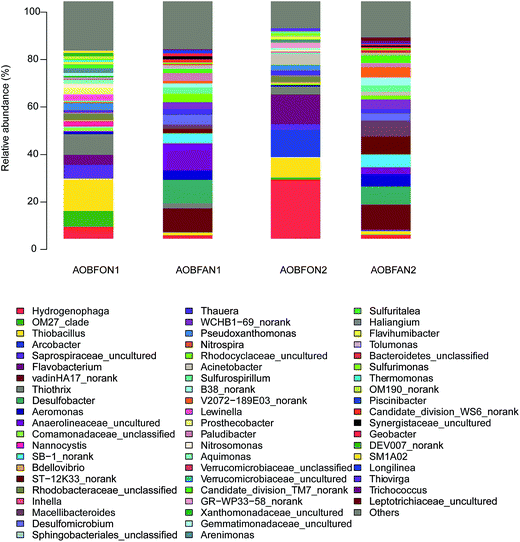 | ||
| Fig. 8 Relative abundance of the genera identified in the samples obtained from the anoxic and oxic zones of A/O-BAF process at different ammonia nitrogen loads. | ||
Microbial groups were observed in the oxic zones in A/O-BAF process of different ammonia nitrogen loads in Thiobacillus (13.70%), Thiothrix (8.64%), Saprospiraceae_uncultured (5.70%), Hydrogenophaga (4.95%), Pseudoxanthomonas (4.95%), Flavobacterium (4.25%) in AOBFON1 and Hydrogenophaga (24.91%), Flavobacterium (12.53%), Arcobacter (11.52%), Thiobacillus (8.52%), Acinetobacter species (4.50%), Thiothrix (3.39%) in AOBFON2.
Although both samples had the same dominant genus (Thiobacillus, Thiothrix, Hydrogenophaga, and Flavobacterium), the microbial communities between AOBFON1 and AOBFON2 were significantly distinct on the genus level. Thiobacillus were reported to be the main degraders for thiocyanate and widespread in coking wastewater treatment systems. Meanwhile, they have been extensively applied for denitrification processes of the superior denitrification capacity.15,16 Thiothrix can reduce nitrite and/or nitrous oxides (denitrification) under anaerobic growth. Hydrogenophaga, an autotrophic H2-oxidizing bacterium that utilizes hydrogen as an energy source,17 was found to be accumulated in the AOBFON2 sample (24.91% – Hydrogenophaga). However, it only accounted for 4.95% in AOBFON1. It should be noted that Hydrogenophaga could degrade 4-aminobenzene sulfonate,18 xenobiotic compounds, such as polychlorinated biphenyl and methyl tert-butyl ether.19,20 Microbes belonging to the Flavobacteriaceae family, such as Flavobacterium, were also distinguished when utilizing acetate to stimulate activated sludge.21 However, it should be established that organic carbon and active denitrifying population of microbes were also associated.
Interestingly, the microbial community structures between AOBFAN1 and AOBFAN2 samples were also different from the anoxic zone of A/O-BAF process of the different ammonia nitrogen loads (Fig. 7). Anaerolineaceae_uncultured was the most dominant bacteria in the AOBFAN1 sample of a relative abundance of 11.35%, followed by vadinHA17_norank (9.91%), Desulfobacter (9.76%), Desulfomicrobium (4.26%), Aeromonas (4.26%), SB-1_norank (4.16%). VadinHA17_norank was the most dominant bacteria in AOBFAN2 samples of a relative abundance of 10.44%, followed by ST-12K33_norank (7.55%), Desulfobacter (7.43%), Bacteroides (6.51%), SB-1_norank (5.43%), and Aeromonas (5.41%). VadinHA17_norank, Desulfobacter, Aeromonas and SB-1_norank were the dominant genera shared by both AOBFAN1 and AOBFAN2 samples, and these genera have been reported to be frequently responsible for the degradation of compounds in biofilters.22–25 Desulfobacter and Aeromonas are other anaerobic bacterias in the anoxic zone.26–28 The microbial population and physicochemical properties of the UCSFMs well explained the excellent performance of the UCSFM A/O-BAF reactor.
4. Conclusions
A considerable amount of oyster shells is produced as waste product of mariculture every year, which leads to a major disposal problem with coastal regions of China. This work investigated the possibility of converting the oyster shell waste into the UCSFM by an unburned process, and examined the performance of the UCSFM serving as the bio-carrier in the A/O-BAF reactor. The results were as follows:(1) The feasibility of UCSFM as a biofilm supported by A/O-BAF was verified quite satisfactorily according to the results of characteristics of UCSFM.
(2) UCSFM BAF had a slightly higher COD and NH3–N removal efficiency compared to UCSFM A/O-BAF, but UCSFM A/O-BAF showed higher TN removal efficiency of ammonia nitrogen loads between 0.130 kg (m3 d)−1 and 0.496 kg (m3 d)−1. UCSFM A/O-BAF and UCSFM BAF had average TN removals of 41.88% and 7.48%, respectively. The richness of the bacterial communities in the anoxic zone of A/O-BAF operated on the ammonia nitrogen load of 0.130 kg (m3 d)−1 was higher than that under the ammonia nitrogen load of 0.1496 kg (m3 d)−1.
(3) Pyrosequencing analysis of the 16S rRNA gene in anoxic/oxic zones of A/O-BAF process indicated that the microbial communities between the two samples were quite different to different ammonia nitrogen loads. Thiobacillus, Thiothrix, Hydrogenophaga, and Flavobacterium were the dominant genera shared in the oxic zones, while VadinHA17_norank, Desulfobacter, Aeromonas and SB-1_norank were the dominant genera shared in the anoxic zones. The microbial population and physicochemical properties of the UCSFMs well explained the excellent performance of the UCSFM A/O-BAF reactor.
Therefore, oyster shell waste can be converted to the UCSFM, which has good biofilm adhesion and adsorption properties and can be used as an excellent bio-carrier for microorganisms in A/O-BAF reactor.
Acknowledgements
This work was funded by the National Natural Science Foundation of China (NSFC51508227, NSFC51278225, and NSFC51178207), A Project of Shandong Province Higher Educational Science and Technology Program (No. J14LG02), Shandong Province Science and Technology Development Plan-Policy Guidance Project (No. 2013YD17003).References
- C. L. Li, A. H. Song, W. Hu, Q. C. Li, B. Zhao, R. J. Zhu, Y. Zhang and D. P. Ma, Status analyzing and developing counter-measure of cultured scallop industry in Shandong province, Mar. Sci., 2011, 35(3), 93–98 Search PubMed.
- Y. W. Ding, L. Wang, B. Z. Wang and Z. Wang, Removal of nitrogen and phosphorus in a combined A(2)/O-BAF system with a short aerobic SRT, J. Environ. Sci., 2006, 18, 1082–1087 CrossRef CAS.
- G. Farabegoli, A. Chiavola and E. Rolle, The biological aerated filter (BAF) as alternative treatment for domestic sewage. Optimization of plant performance, J. Hazard. Mater., 2009, 171, 1126–1132 CrossRef CAS PubMed.
- D. Gao, Z. Li, J. Guan, Y. Li and N. Ren, Removal of surfactants nonylphenol ethoxylates from municipal sewage-comparison of an A/O process and biological aerated filters, Chemosphere, 2014, 97, 130–134 CrossRef CAS PubMed.
- Y. Feng, J. Qi, L. Chi, D. Wang, Z. Wang, K. Li and X. Li, Production of sorption functional media (SFM) from clinoptilolite tailings and its performance investigation in a biological aerated filter (BAF) reactor, J. Hazard. Mater., 2013, 246–247, 61–69 CrossRef CAS PubMed.
- J. H. Ha and S. K. Ong, Nitrification and denitrification in partially aerated biological aerated filter (BAF) with dual size sand media, Water Sci. Technol., 2007, 55(1–2), 9–17 CrossRef CAS PubMed.
- T. D. Kent, C. S. B. Fitzpatrick and S. C. Williams, Testing of Biological Aerated Filter (BAF) Media, Water Sci. Technol., 1996, 34(3–4), 363–370 CrossRef.
- M. F. Rosa and A. A. L. Furtado, Biofilm development and ammonia removal in the nitrification of a saline wastewater, Bioresour. Technol., 2008, 65, 135–138 CrossRef.
- O. Francisco and H. Ernesto, Wastewater treatment with a double-layer submerged biological aerated filter, using waste materials as biofilm support, Environ. Manage., 2002, 65, 79–84 Search PubMed.
- S. Han, Q. Yue, M. Yue, B. Gao, Y. Zhao and W. Cheng, Effect of sludge-fly ash ceramic particles (SFCP) on synthetic wastewater treatment in an A/O combined biological aerated filter, Bioresour. Technol., 2009, 100, 1149–1155 CrossRef CAS PubMed.
- Y. Feng, Y. Yu, Q. Duan, J. Tan and C. Zhao, The characteristic research of ammonium removal in grain-slag biological aerated, Desalination, 2010, 263, 146–150 CrossRef CAS.
- L. P. Qiu and J. Ma, Characters of biofilm and its microorganism population in biological aerobic filter, China Environ. Sci., 2005, 25, 214–217 CAS.
- State Environmental Protection Administration of China, Monitoring and Analysis Methods of Water and Wastewater, China Environmental Science Press, Beijing, 4th edn, 2002 Search PubMed.
- A. Albuquerque, A. Gonzalez-Martinez and F. Osorio, Effect of aeration on steady-state conditions in non- and partially aerated low-loaded biofilter, J. Environ. Sci. Technol., 2012, 9, 395–408 CAS.
- H. R. Beller, P. S. Chain, T. E. Letain, A. Chakicherla, F. W. Larimer and P. M. Richardson, et al., The genome sequence of the obligately chemolithoautotrophic, facultatively anaerobic bacterium Thiobacillus denitrificans, J. Bacteriol., 2006, 188, 1473–1488 CrossRef CAS PubMed.
- J. Y. Park and Y. J. Yoo, Biological nitrate removal in industrial wastewater treatment: which electron donor we can choose, Appl. Microbiol. Biotechnol., 2009, 82, 415–429 CrossRef CAS PubMed.
- K. Yoon, Y. Sakai, N. Tsukada, K. Fujisawa and H. Nishihara, Purification and biochemical characterization of a membrane-bound [NiFe]-hydrogenase from a hydrogen-oxidizing, lithotrophic bacterium, Hydrogenophaga sp. AH-24, FEMS Microbiol. Lett., 2009, 290, 114–120 CrossRef CAS PubMed.
- H. M. Gan, S. Shahir, Z. Ibrahim and A. Yahya, Biodegradation of 4-aminobenzenesulfonate by Ralstonia sp PBA and Hydrogenophaga sp PBC isolated from textile wastewater treatment plant, Chemosphere, 2011, 82, 507–513 CrossRef CAS PubMed.
- P. B. Hatzinger, K. McClay, S. Vainberg, M. Tugusheva, C. W. Condee and R. J. Steffan, Biodegradation of methyl tert-butyl ether by a pure bacterial culture, Appl. Environ. Microbiol., 2001, 67, 5601–5607 CrossRef CAS PubMed.
- A. J. Lambo and T. R. Patel, Cometabolic degradation of polychlorinated biphenyls at low temperature by psychrotolerant bacterium Hydrogenophaga sp. IA3-A, Curr. Microbiol., 2006, 53, 48–52 CrossRef CAS PubMed.
- T. Osaka, S. Yoshie, S. Tsuneda, A. Hirata, N. Iwami and Y. Inamori, Identification of acetate- or methanol-assimilating bacteria under nitrate reducing conditions by stable-isotope probing, Microb. Ecol., 2006, 52, 253–266 CrossRef CAS PubMed.
- I. Krustok, J. Truu, M. Odlare, M. Truu, T. Ligi, K. Tiirik and E. Nehrenheim, Effect of lake water on algal biomass and microbial community structure in municipal wastewater-based lab-scale photobioreactors, Appl. Microbiol. Biotechnol., 2015, 99(15), 6537–6549 CrossRef CAS PubMed.
- I. V. Trubitsyn, E. V. Belousova, M. N. Tutukina, A. Y. Merkel, G. A. Dubinina and M. Y. Grabovich, Expansion of ability of denitrification within the filamentous colorless sulfur bacteria of the genus Thiothrix, FEMS Microbiol. Lett., 2014, 358(1), 72–80 CrossRef CAS PubMed.
- P. Jordan, E. A. Marchand, J. Silverstein and M. Hernandez, Development and Application of Small-Subunit rRNA Probes for Assessment of Selected Thiobacillus Species and Members of the Genus Acidiphilium, Appl. Environ. Microbiol., 2000, 66(7), 3065–3072 CrossRef.
- D. C. Yang, W. T. Im, M. K. Kim and S. T. Lee, Pseudoxanthomonas koreensis sp. nov. and Pseudoxanthomonas daejeonensis sp. nov, Int. J. Syst. Evol. Microbiol., 2005, 55, 787–791 CrossRef CAS PubMed.
- R. M. Abed, N. Musat, F. Musat and M. Mussmann, Structure of microbial communities and hydrocarbon-dependent sulfate reduction in the anoxic layer of a polluted microbial mat., Mar. Pollut. Bull., 2011, 62(3), 539–546 CrossRef CAS PubMed.
- A. M. Vieira, R. Bergamasco, M. L. Gimenes, C. V. Nakamura and B. P. Dias Filho, Microbial populations of an upflow anaerobic sludge blanket reactor treating wastewater from a gelatin industry, Environ. Technol., 2001, 22(12), 1477–1485 CrossRef CAS PubMed.
- T. Hao, L. Wei, H. Lu, H. Chui, H. R. Mackey, M. C. van Loosdrecht and G. Chen, Characterization of sulfate-reducing granular sludge in the SANI(R) process, Water Res., 2013, 47(19), 7042–7052 CrossRef CAS PubMed.
| This journal is © The Royal Society of Chemistry 2016 |


